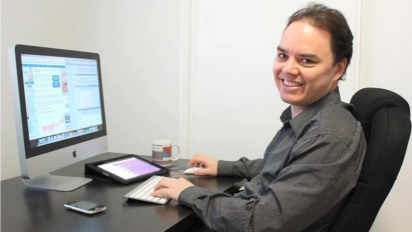“The climate is always changing.”
“Scientists disagree about the causes.”
“Animals and plants can just adapt.”
The three false statements above are just a few of the biggest misconceptions about climate change that afflict many individuals—including students. How should educators combat these misconceptions? According to John Cook, Research Assistant Professor at the Center for Climate Change Communication at George Mason University, the best approach is to tackle them head-on and leverage the misconceptions into learning opportunities. The creator of the website Skeptical Science and co-author of several books on climate change denial, Cook works closely with NCSE’s Turning Misconceptions into Educational Opportunities (TMEO) Teacher Ambassadors in developing misconception-based lessons and related professional development for science educators.
In an era when misinformation is prevalent, and easily disseminated, John Cook’s approach helps students (and non-students) separate fact from fiction, guiding them on a path of scientific understanding about climate change. We decided to interview Cook about his misconceptions work to gain insight into what has been recognized as an extremely powerful way to help young people construct their own understanding of climate change. Our exchange has been edited for sense and length.
My first question is pretty basic: Why misconceptions?
John Cook: To quote that famous educator Yoda, “You must unlearn what you have learned.” Misconceptions interfere with new learning. They can give students false confidence that they understand a phenomenon when their understanding is actually faulty. And in the worst case, misinformation can stop people from acknowledging facts. For example, studies have shown that when people are presented with facts and corresponding misinformation that distorts those facts, if they don’t have a way of resolving the conflict between the two, there’s a danger that they’ll disengage and not even accept the facts. Misinformation can cancel out factual information.
I know that you recognize the importance of misconception-based teaching in general, but you also have a particular interest in misconceptions about climate change. Of all the climate misconceptions, which do you most wish you could bust permanently?
JC: The most damaging climate misconception is that climate scientists disagree on human-caused global warming. Only around 10 percent of Americans are aware that over 95 percent of climate scientists agree that humans are causing global warming. The reason this is so important is because perceived lack of consensus is a gateway misconception—it not only affects views on whether climate change is happening and whether it’s human-caused, but also colors willingness to support climate action. Fortunately, it’s one of the easier misconceptions to dispel, as it just requires communicating a single number: 97 percent of climate scientists agree on human-caused global warming.
So if a teacher has just one lesson to cover climate change, I assume that mentioning the 97 percent consensus would be important? Anything else?
JC: Yes, absolutely you need to bring up the consensus— that is critical, and as I said, it doesn’t take up much time. In fact, a complete explanation of climate change can be compressed to just ten words: “It’s real. It’s us. It’s bad. Experts agree. There’s hope.” In other words, climate change is happening; human activity is causing it; the impacts are serious and already happening; there’s scientific consensus (97 percent!) on the first three points; but we have all the technology we need to avoid the worst impacts of climate change.
Okay, that’s what educators should do. How about what they should definitely not do?
JC: There are two aspects to climate change: the problem and the solutions. What we should avoid is only giving half the picture. If we only communicate the problem, it ends up being a doom-and-gloom message that can actually paralyze people and cause them to disengage from the issue. While if we only communicate the solutions, that’s a positive message, but it lacks the urgency that the dire situation of climate change dictates. We need to communicate both—climate change is a dire, immediate problem, but we can solve it if we act with urgency.
Speaking of communication, what would you change about how the popular news media covers climate change?
JC: The media does a lot of damage through false balance—by giving deniers equal weight with climate scientists. Research (including my own) has shown that this conveys the impression of a 50–50 scientific debate, lowers public perception of scientific consensus, and reduces acceptance of climate change. But the news media could cover climate change accurately, while fulfilling the journalistic norm of balance, by communicating the weight of evidence or the weight of experts. For example, they can acknowledge the existence of contrarian voices while also pointing out that they are a vanishingly small minority.
What I notice about the way the media covers climate change, besides the false balance you mention, is that it is often so bleak. I usually feel a certain amount of despair as I get more informed. Do you feel that, too? How do you fight despair?
JC: I remind myself that climate change is not a binary proposition. It’s not a case of suffering climate impacts or avoiding climate impacts. Climate change is a matter of degrees (literally). Every scrap of action now means some amount of avoided climate impacts down the track. So I continue to fight, and communicate the reality of climate change, so we will take actions now that will reap dividends well into the future.
That helps, thanks. I’m going to try to internalize that message, and I hope our readers do, too. Is there anything else you’d like to share about your misconceptions work?
JC: Misconceptions are an unfortunate reality, but they’re also an opportunity. Misconception-based learning is one of the most powerful ways of teaching science. Not only do students achieve stronger learning gains (compared to straight teaching of the science), but also the learning gains last longer. The students develop critical thinking skills that they can apply to all different forms of misconceptions and misinformation. They come away empowered to talk about the issue, which is crucially important with climate change, since climate silence is an impediment to meaningful societal progress. So I suggest that rather than running from misinformation and denial, we use its presence as a powerful educational opportunity.
Thank you so much for all of your work. Our Teacher Ambassadors have embraced your approach in the lessons they’ve developed—and continue to develop—and I really look forward to spreading the word about the power of misconception-based teaching with your continued help.
A modified version of this post originally appeared in Reports of the National Center for Science Education 39(1). If you like this interview, you're going to love the whole issue.


